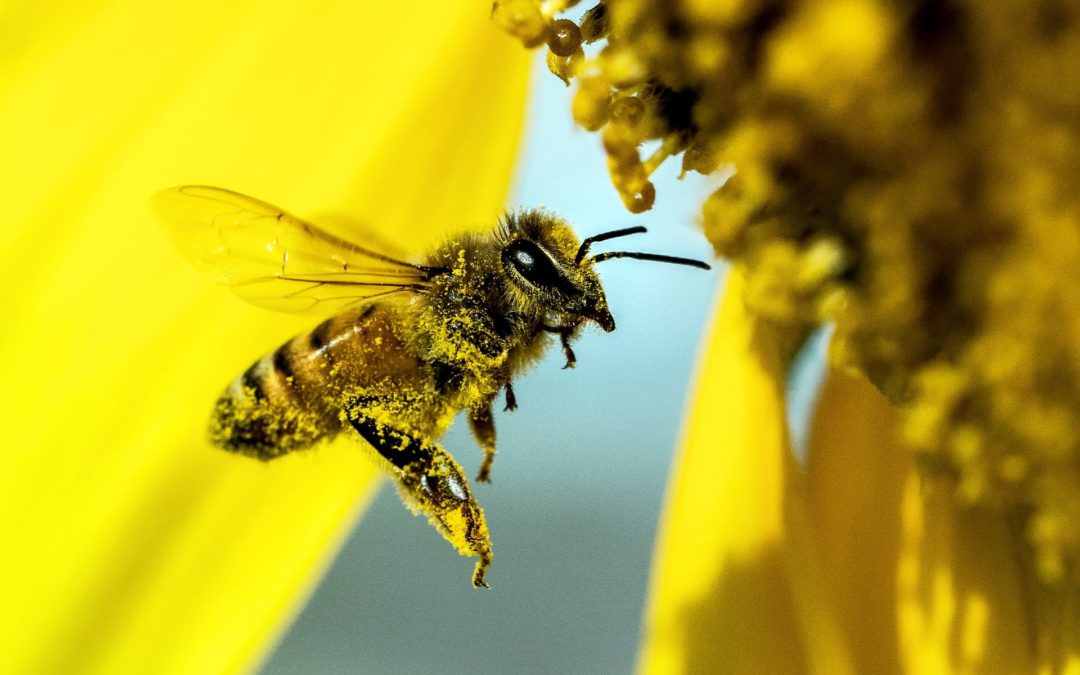Have you eaten yet today? Yes? Well, you can thank pollinators for at least one out of every three bites that you took. Or maybe you’re the type of person to skip breakfast. Did you have a cup of coffee, or perhaps tea? Pollinators were responsible for that, too.
Although there are many different types of pollinators – ranging from insects to birds to small mammals – bees are the most efficient of them all, and none more so than the honey bee. Honey bees actually represent seven various bee species, with the most common one bee-ing Apis mellifera, also known as the western honey bee. Despite having “honey” in their name, honey bees produce much more than just honey. As general pollinators, they will pollinate most flowering plants, including fruits, vegetables, nuts, sugarcane, and yes, those precious coffee beans! They are born to pollinate, which is why they have so much hair all over their body. If you look close enough, you can even see hair on their eyeballs. The exceptional pollinating ability of the honey bee makes them indispensable to global biodiversity as well as agriculture, so it’s a good thing they can be found in every continent (except Antarctica). In the U.S. alone, the pollination services of honey bees provide an estimated $15 billion to the economy, and they are commercially used to pollinate over 100 different crops.
Each honey bee colony consists of three types of bees: workers, drones, and the queen. Workers are females who do not lay eggs and they form the majority of the colony. True to their name, they do all the work. The youngest workers are tasked with cleaning the hive, as well as caring for larvae and the queen. As they mature, workers become responsible for constructing honeycombs, feeding the drones, storing incoming nectar, and guarding the hive entrance. The oldest workers are the ones responsible for foraging and pollinating. Drones, on the other hand, have it easy. The stingless male bees have nothing to do except mate with the queen, eat, and rest. (Clearly the phrase “busy as a bee” refers to the ladies of the colony.) Last but certainly not least, the queen bee is responsible for reproduction. She can lay up to 2,000 eggs per day, amounting to potentially one million in her lifetime. She also produces pheromones which allow her to communicate with the hive, control social behaviors, and suppress the reproductive abilities of the worker bees. If anything happens to the queen, the hive will quickly notice because of the change in pheromone levels.
Honey bees drew international attention about 15 years ago when beekeepers became alarmed by the sudden disappearance of worker bees. This phenomenon was given the name Colony Collapse Disorder (CCD) and it took off at a frightening rate. CCD was first discovered in 2006, and by 2008 it accounted for 60% of all hives lost. Those numbers have since decreased to about 20% by 2018, which is excellent news, except that scientists don’t know what caused that dramatic decrease. They don’t even know for sure what caused CCD in the first place, although they have identified the major threats to honey bees that are the most likely contributing factors. The primary suspect is exposure to neonicotinoids, a type of pesticide commonly used in industrial farming. Neonicotinoids cause symptoms similar to Alzheimer’s disease, which disrupts the homing abilities of the worker bees. This offers a logical explanation as to why honey bees are disappearing rather than dying in their hives. Other potential factors include disease (often spread by mites) and poor nutrition due to the effects of climate change. Despite the recent reduction of CCD cases, 40% of beehives were still lost in 2018. The typical rate of hive loss is 5-10%. CCD has not received as much attention in the media for several years, but we must ask the scientific community to remain vigilant in their research on this issue. Because we proved neither the cause of CCD nor the reason for its decline, we have no way of preventing or responding to future outbreaks.
On a final note, although honey bees are critically important, we cannot forget that there are approximately 20,000 other species of bees around the world. Diversity of bee species is an indispensable aspect of pollination that does not receive enough attention, and all these other species are also at risk. If we don’t protect the bees that drive so much of our food production, we don’t stand a chance of combatting our global food crisis. Bees are perhaps the most obvious example of how humans have an obligation to the conservation of nature for the sake of our own wellbeing.
Sources:
http://www.keephivesalive.org/
https://www.planetbee.org/why-we-need-bees
https://www.pollinator.org/pollinated-food
https://www.worldatlas.com/articles/the-seven-species-of-honey-bees-living-today.html
https://www.uaex.edu/farm-ranch/special-programs/beekeeping/about-honey-bees.aspx
